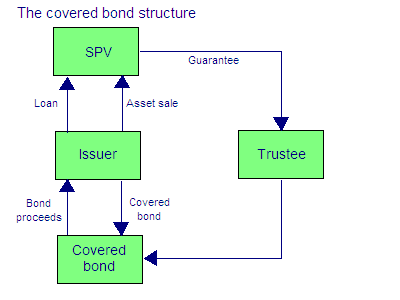
Barbican Consulting Limited
Covered Bonds

Introduction
Covered bonds offer both banks and building societies the opportunity to raise much needed long term liquidity at a cost that is lower than that of senior debt. This is because for the investor there is a ring fenced pool of mortgage collateral and this provides enhanced security should the issuer default. It is therefore no surprise that regulators in many countries are keen to encourage covered bond issuance in order to resolve the funding gap that many banks have in their balance sheets.
What is a covered bond?
Covered bonds are structured bonds. They are backed by mortgages that are held in a separate legal entity called a Special Purpose Vehicle (SPV).
Under normal conditions the investor can expect the covered bond issuer to repay both principal and interest. However if the issuer does not perform the investor can look to get payment from the asset pool in the SPV. However in the event that the assets are insufficient the investor becomes an unsecured creditor of the issuer for any outstanding amount.
It is this recourse by the investor first to the issuer and then if need be to the assets that makes covered bonds a relatively safe investment. It is also why many covered bonds have a AAA rating.
Legal structure
The legal structure of a covered bond is very important to investors. This is because they must be certain that the assets are appropriately ringfenced from other creditors should bankruptcy arise. Whilst this article does not deal with the legal structure in detail it is important to note that there are several legal structures and these depend on the country in question. In Continental Europe legislation has been enacted to permit the issuance of covered bonds. In Common Law counties like the UK a security interest structure is used.
UK Structure
Before issuing both banks and building societies must be registered to issue covered bonds with the FSA.
The issuer sets up an SPV. This is normally a Limited Liability Partnership (LLP). The LLP will become the owner of the asset pool.
The bank or society then issues the covered bond. The issuance proceeds are received and must then be used to make a loan to the SPV. The SPV must then use the loan to purchase the assets from the issuer.
In order to protect the investor a guarantee is granted by the SPV using a trustee. This guarantee protects the covered bond investor, (see diagram below):

Interest and principal repayment
Interest and principal is paid by the issuer. However if the issuer defaults the asset pool provides the repayment. For this reason the issuer must maintain and administer the assets so they are always sufficient to meet any claims that could arise on them. To ensure this happens the SPV is subject to regulations imposed by the FSA.
The asset pool
In order to protect the investor there are regulations in place that restrict the assets that are eligible for the covered bond pool. These regulations are designed to protect investors. For example under EU regulation loans secured on residential property that are in the pool may only have a loan to value ratio (LTV) of up to 80%. (Higher LTV ratios put the lender at more risk because there is less underlying collateral cover for the loan).
The asset pool is dynamic this means that mortgages can be moved in and out of the pool. This has important consequences for both the issuer and the investor. The issuer is obliged to ensure that mortgage assets are current and not in arrears. If they are in arrears they must be replaced.
This improves investor protection but also means that the issuer is not transferring the risk of the assets to the investor. In this respect covered bonds are not like mortgage backed securities where there is risk transfer to the investor.
It also means that the issuer does not get capital relief when a covered bond is issued because the risk is not "off balance sheet". The purpose of the covered bond is to raise money not transfer risk.
The enhanced investor protection means that if a bank invests in a covered bond it has a 10% risk weighting as opposed to 20% for AAA corporate.
Pre-payment risk
The dynamic nature of the asset pool also means that it is likely that there will be a fixed repayment date (this is known as a hard bullet) for the covered bond.
Because repayment is in the first instance coming from the issuer rather than the asset pool and the collateral pool must be maintained at all times the investor does not suffer pre-payment or extension risk (which is common with mortgage backed securities).
(Prepayment is the risk where the duration of the bond can alter during its life because the capital repayment speeds alter in response to interest rates or economic conditions thus affecting the capital redemption date).
Registration with the FSA
Before issuing covered bonds a prospective issuer must apply for registration with the FSA. This registration and information that goes with it must be signed off by a senior manager who then retains ongoing responsibility to ensure compliance with the Regulations and Sourcebook.
The FSA with its own team undertakes an independent analysis of the issuer and its plans for covered bond issuance. This analysis includes an assessment of the governance framework, the quality of the assets, the legal documentation to be used and the ability to repay investors. The issuer must also submit stress tests related to the assets. The regulator re-evaluates the stress tests using its own model.
There is also an on-site visit by the FSA to review creditworthiness and governance issues.
Stress testing
In order to protect investors, the issuer undertakes regular stress tests that are built into legal documentation of the programme.
Stress testing leads to overcollateralistion. Overcollateralisation is where the issuer is obliged to retain a pool of assets that have a value that exceeds the value of the bonds issued.
In the event that the issuer defaults overcollateralisation protects investors because the asset pool will become the primary source of repayment.
The issuer must also provide the FSA with regular information about the asset pool. The FSA uses this data together with its own market data to stress test the asset pool on a quarterly basis.
The FSA's stress testing is separate from and independent to the stress testing undertaken by the issuer as part of its legal requirement under the programme. In undertaking its stress testing the FSA considers default risk, pre-payment risk, currency risk, interest rate risk, counterparty risk on hedging contracts and liquidity risk (the inability to sell assets in a short period of time in order to repay investors).
Additional stress testing by the FSA can also occur on an ad hoc basis for example when assets are transferred into or out of the pool by the issuer.
The FSA's stress testing leads to a mandatory overcollateralisation ratio for each individual covered bond programme.
When the FSA is split into The Prudential Regulation Authority (PRA) and The Financial Conduct Authority (FCA) the regulation of covered bonds will transfer to the FCA.
Risks for the issuer
Covered bonds do not transfer credit risk to the investor. It remains on the originator's balance sheet. With this in mind the quality of underwriting must always be under the spotlight to ensure standards are maintained.
If property prices decline LTV ratios will increase and the issuer may be required to find additional suitable collateral. Similarly when assets are removed from the pool because they are in arrears there must be sufficient high quality assets available to replace them.
Whilst funding from covered bonds may be cheaper the sum of money raised through a covered bond is less than the value of the assets in the pool. This will increase the cost of funding beyond the cost of the covered bond issue.
Covered bonds are one potential source of funding and covered bond programmes should be integrated into the funding plan. The crisis uncovered weaknesses in business models that were over reliant on single funding sources (wholesale and structured debt markets). Is it possible that disruption in a large covered bond market in the future could lead to similar problems?
Prepayment risk remains with the issuer and this was discussed earlier in this article.
Risks for the investor
With the dual recourse structure the investor should look at the credit standing of the issuer and also the credit quality of the asset pool. Whilst covered bonds are regulated and there are rules around the asset pool including overcollateralisation the investor should consider the quality of the underlying mortgage loans, the standards of underwriting and the quality and selection of assets added to the pool. After all should the issuer default this is where repayment will need to come from.
Further questions
Small mortgage lenders: In the future bank senior debt holders are likely to face a bail in or haircut should default occur. Provided the legal structure is watertight covered bond investors would be sheltered from this event. This risk should continue to make covered bonds a cheaper source of term funding for banks. Will financial institutions that cannot issue covered bonds find themselves permanently disadvantaged?
Unsecured creditors: Ringfencing assets for particular creditors potentially means that in bankruptcy there are fewer assets available for unsecured creditors, this includes senior debt holders. Will covered bonds lead to the unintended consequence of substantially increasing the cost of senior debt for those that rely on covered bond programmes?
Regulators: Covered bonds may well meet the needs of banks to refinance their balance sheet but by ringfencing assets are other creditors disadvantaged? In bankruptcy if it means that senior debt holders are left with lower recovery rates then are we sufficiently certain that taxpayers will not end up footing an even larger bill? Surely there needs to be co-ordination between covered bond and bail in legislation. Furthermore what limits do you individually and collectively put on banks using covered bonds?
And finally.........
Covered bonds aren’t new. In Germany they are called Pfandbrief and this market goes back over 300 years.
First published by Barbican Consulting Limited 2007